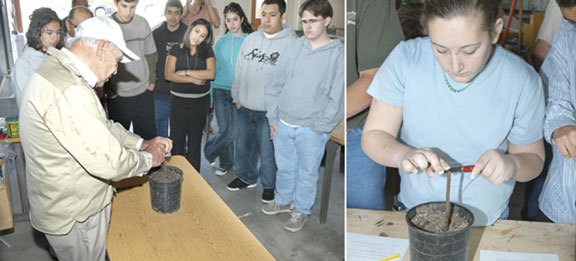Joe Sabol, director of outreach for the College of Agriculture at Cal Poly, indicated the high success rate expected from the high school students. “Last year we had many high school agriculture programs participate in the program, and nearly every school had well over 90% success with their graft.”Apple trees produced by the Santa Paula High School students will be used to develop a Supervised Occupational Experience Project as an orchard at the school farm, or taken to be projects at home. Some trees will be sold, used for awards banquets, and budded in the next year to add a second variety in September.For further information on this project, call the Santa Paula Agriculture Department at 525-4592.

|
Pictured at left, Dick Watts, California Rare Fruit Growers, Ventura County Chapter, demonstrates how to do an apple graft. At right, Sarah Christman, sophomore, cuts into the rootstock in preparation for an apple graft Thrusday morning at Santa Paula High School. Photos by Don Johnson |
SPHS students learn apple grafting
March 18, 2005
Cal Poly, CRFG and Santa Paula High School graft apples
Santa Paula High School
By Sonia Magana, FFA Sentinel
Agriculture students at Santa Paula High School learned to graft apples with a “Learn by Doing” demonstration from Cal Poly agriculture students and members of the California Rare Fruit Growers, Ventura County Chapter.The SPHS Agriculture Department recently purchased 100 semi-dwarf apple rootstocks from the CRFG. These rootstocks are then grafted over the students’ favorite variety of apple. Grafting is common in the fruit orchard and the nursery to produce trees and fruit that are true to form and taste.The members of the CRFG assisted with the grafting process and provide the semi-dwarf rootstock. Students from Cal Poly include Agriculture Ambassadors and students majoring in fruit and crop production, environment horticulture, and agricultural education.High school agriculture instructor Alex Flores said, “It is a great way for our students to learn to graft and meet some college students who are pursuing careers in agriculture. In addition, the price is right!” The rootstock will produce a “semi-dwarf” apple tree, which will grow to be about 70% as tall as a full sized tree.According to Bob Vieth, member of the Ventura County Chapter CRFG, the grafting technique is not a difficult one. It involves the use of a very sharp knife to expose both the rootstock and the dormant top, called a scion. These two plants then heal together and grow into a single tree. Students will know if their graft is successful in just a few short weeks, when the top begins to grow new leaves.In one year, the trees will grow to be three to five feet tall. These will be planted or moved to a larger plant container. The tree will be allowed to set only one apple in their second year, because the goal is to produce a big strong tree at this early age rather than produce five to ten apples.


